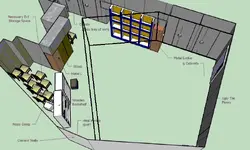C
corban
New member
I have a room I can set up as a studio in a church basement. It’s pretty much a big weird storage room, some areas of the ceiling are lower than others to accommodate an airflow duct. At its largest it’s 26 ½ x 35 1/3 x 7 2/3. The ceiling is some sort of suspended corkboard or something, it’s quite rigid but can be pressed into with your fingernail. I imagine it’s somewhat absorptive. I’m sitting in school right now and the ceiling is the same material. Above that ceiling there’s 16” before things get solid. There’s all sorts of pipes and such up there.

As you can see it has some pretty sweet dimensions considering it's a church basement, with the walls angled away from what seems like an ideal mixing spot. At the back of the room, behind that mixing spot is some sort of wooden structure that I’ve realized I could slip fibreglass into and make into a basstrap of sorts. The fibreglass would be facing outwards, and I would hope that this system would benefit from some empty space behind it for eliminating lower frequencies. Behind it is about 4 feet of storage space with a low ceiling.
The problem is there are stacks of shitty old chairs and some doors that need to be stored in there. I could maybe make a stink and get rid of some, but I don’t wanna push my luck as I’m using this for free. I’ve organized most of them into the corner and separated that area with a big bookshelf, and I figured I could also put my computer behind there for noise separation. The other options for computer placement would be in one of the closets I guess. Unfortunately with this bookshelf setup I can’t really take advantage of that sweet mixing spot. Instead I’m forced into the setup I’ve outlined in the picture, with a mixing position that isn’t quite ideal, since the angles of the left wall and right bookshelf would give me some inconsistent reflections and probably mess up my stereo imaging.
I have some portable fibreglass panels for absorption that I could place on the sides to cut down on side reflections skewering my response. Any thoughts on this? Is that a decent mix position or should I work hard to get the better one to work? I could spread those chairs out around the walls of the room where they could act as diffusers, it would just be uglier than it is already, and I will have clients down there.
As it is set up right now I plan on throwing a whole bag of rigid fibreglass into the corner with all the chairs to absorb some bass back there, as well as in the corner by the door in the top right. There’s a fair amount of diffusing type things in the room and very few parallel reflective surfaces but I suspect I could use a little more broadband absorption. I’m not handy at all when it comes to building things so I'm trying to avoid building any wooden traps but I’m open to other suggestions, and appreciate any feedback.

As you can see it has some pretty sweet dimensions considering it's a church basement, with the walls angled away from what seems like an ideal mixing spot. At the back of the room, behind that mixing spot is some sort of wooden structure that I’ve realized I could slip fibreglass into and make into a basstrap of sorts. The fibreglass would be facing outwards, and I would hope that this system would benefit from some empty space behind it for eliminating lower frequencies. Behind it is about 4 feet of storage space with a low ceiling.
The problem is there are stacks of shitty old chairs and some doors that need to be stored in there. I could maybe make a stink and get rid of some, but I don’t wanna push my luck as I’m using this for free. I’ve organized most of them into the corner and separated that area with a big bookshelf, and I figured I could also put my computer behind there for noise separation. The other options for computer placement would be in one of the closets I guess. Unfortunately with this bookshelf setup I can’t really take advantage of that sweet mixing spot. Instead I’m forced into the setup I’ve outlined in the picture, with a mixing position that isn’t quite ideal, since the angles of the left wall and right bookshelf would give me some inconsistent reflections and probably mess up my stereo imaging.
I have some portable fibreglass panels for absorption that I could place on the sides to cut down on side reflections skewering my response. Any thoughts on this? Is that a decent mix position or should I work hard to get the better one to work? I could spread those chairs out around the walls of the room where they could act as diffusers, it would just be uglier than it is already, and I will have clients down there.
As it is set up right now I plan on throwing a whole bag of rigid fibreglass into the corner with all the chairs to absorb some bass back there, as well as in the corner by the door in the top right. There’s a fair amount of diffusing type things in the room and very few parallel reflective surfaces but I suspect I could use a little more broadband absorption. I’m not handy at all when it comes to building things so I'm trying to avoid building any wooden traps but I’m open to other suggestions, and appreciate any feedback.



